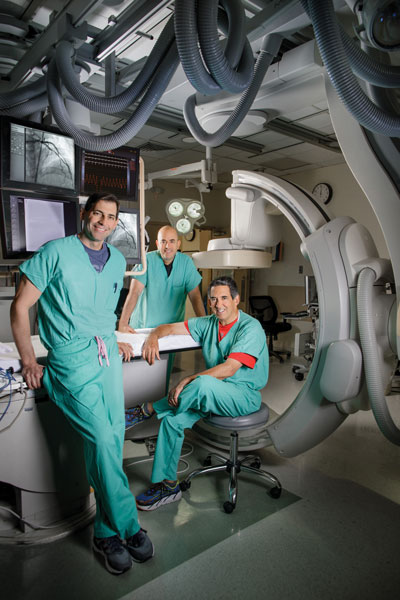2018 Summer

(L to R) MedStar Washington Hospital Center cardiologists Robert Lager, Md, Itsik Ben-Dor, MD, and Robert Gallino, MD, are increasingly using the radial approach in cardiac catherization procedures but maintain expertise in the femoral approach, which is still vital for many cases.
Patients want the least invasive procedures. And for those who need cardiac catheterization, the transradial approach is fast becoming the procedure of choice. While they are increasingly turning to the radial approach, cardiologists at MedStar Heart & Vascular Institute (MHVI) at MedStar Washington Hospital Center say there are still legitimate reasons to maintain expertise in other techniques as well.
Instead of inserting the catheter through the larger femoral artery in the groin, cardiologists insert a small hydrophiliccoated sheath through the radial artery to access the coronary artery. There is less pain, less down time and less risk of postprocedural bleeding—and patients can often eat within an hour of the procedure. And at MHVI’s MedStar Union Memorial Hospital, due to the majority of catheterizations done radially, a dedicated Radial Recovery Lounge was constructed. Modeled after a high-end waiting area, it features a large, open space outfitted with recliners and amenities such as a cafe, internet, and TV.
“It’s remarkable to see how quickly the radial approach has gained traction in just the last 10 years,” says cardiologist Robert Lager, MD, who is based at the Hospital Center. “Now, up to 90 percent of the coronary procedures in other parts of the world, such as Europe, China and India, are performed transradially. It’s more comfortable, and it’s safer.”
In fact, Dr. Lager uses the radial approach in almost 80 percent of the cardiac catheterizations he performs each day. One of the key advantages: patients don’t have to lie flat for four-to-eight hours after the procedure to avoid bleeding, which is required with the transfemoral approach. “You can be up and walking within an hour,” he notes.
Patients in the midst of a heart attack who have been aggressively anticoagulated are another group that benefits from the radial approach, says Dr. Lager. “Their risks are higher for bleeding, and we’ve been able to show in studies that the radial approach, with the better ability to control bleeding, results in lower mortality.”
Yet Dr. Lager and his Hospital Center colleagues Robert Gallino, MD, and Itsik Ben-Dor, MD, also maintain their expertise in the femoral approach. “All the structural work in the heart is done with large catheters,” says Dr. Ben-Dor. “At this point they don’t fit through the radial artery. So you have to be adept at both procedures.”
At the Hospital Center, patients scheduled for radial procedures are prepared pre-operatively for a femoral procedure in the groin as well, notes Lager. “About five percent of the time we run into some anatomic problem,” he says. “If we need to immediately switch over, we are able to do so without any delay.”
Dr. Lager notes that acceptance for new catheterization techniques change slowly. “In the 1960s and 1970s, a more common procedural approach was to use the brachial artery,” he recalls. “Then the majority switched to the femoral technique, which was felt to be much safer.”
When transradial catheterization was introduced, “there was a lot of resistance. It was viewed as unnecessarily complex and more time-consuming.” After more than a decade of use, however, the radial approach has been documented to be safe and effective. Many patients specifically ask for the approach, says Dr. Ben-Dor, because they’ve heard that the recovery is so much easier.
Drs. Gallino and Lager teach the radial approach to new physicians. In fact, many new interventional cardiologists are likely more comfortable with the radial access than the femoral access. Having a balanced approach and an open mind, says Dr. Lager, is critical to effectively reduce bleeding risk and the associated risk of death and heart attack for these procedures.
“You can’t be a zealot about your approach,” he says. “The physician should do what is best, safest and most effective for each patient, and this will require that the choice for a route of access is tailored to the individual clinical situation.”









